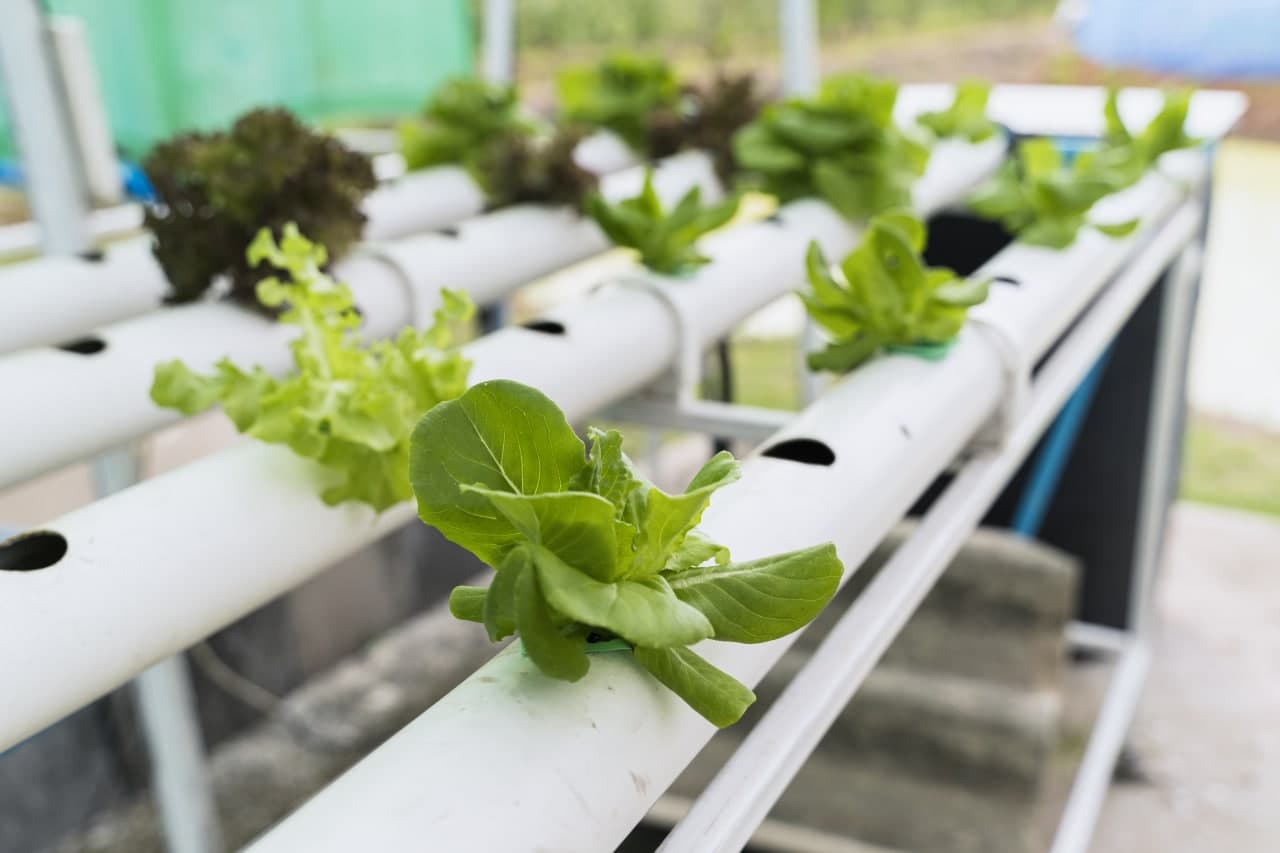Hydroponic gardening represents a revolutionary approach to cultivating plants and vegetables, challenging traditional soil-based methods. This innovative technique relies on a nutrient-rich water solution to nourish plants, eliminating the need for soil. Hydroponics has gained popularity due to its ability to maximize crop yield, conserve resources, and offer more controlled growing conditions. In this exploration of hydroponic gardens, we’ll uncover the principles behind this method, its advantages, and how it’s shaping the future of sustainable agriculture.
The Fundamentals of Hydroponics
Soilless Cultivation:
Hydroponics replaces traditional soil with a carefully balanced nutrient solution, ensuring plants receive essential elements for growth.
Water-Based Systems:
Plants are grown in water-based environments, such as nutrient film technique (NFT) systems, deep water culture (DWC), or aeroponics.
Nutrient Management:
The nutrient solution is precisely controlled to provide plants with the right balance of minerals, vitamins, and water. This eliminates the variability often associated with soil-based cultivation.

Advantages of Hydroponic Gardens
Increased Crop Yield:
Hydroponics can lead to faster growth and higher yields, as plants have direct access to nutrients, resulting in more efficient photosynthesis.
Resource Efficiency:
Water usage is significantly reduced in hydroponic systems, making it a sustainable choice in regions with water scarcity.
Year-Round Cultivation:
Controlled indoor environments enable year-round cultivation, unaffected by seasonality or adverse weather conditions.
Pest and Disease Control:
Hydroponic gardens can be easier to monitor and manage, reducing the risk of pest infestations and diseases.
Space Optimization:
Vertical and compact hydroponic systems make efficient use of space, ideal for urban farming and limited areas.
Disadvantages of Hydroponic Gardens
While hydroponic gardening offers numerous benefits, it’s important to be aware of its potential disadvantages. Understanding these challenges can help you make informed decisions about whether hydroponics is the right choice for your gardening needs. Here are some disadvantages associated with hydroponic gardens:
Initial Setup Cost:
– Establishing a hydroponic system can be more expensive than traditional soil-based gardening. Costs may include specialized equipment, grow lights, nutrient solutions, and a controlled environment.
Technical Knowledge Required:
– Hydroponic gardening demands a good understanding of the system, including water chemistry, nutrient management, and the specific needs of different plant varieties. Novice gardeners may face a learning curve.
Maintenance Intensity:
– Hydroponic systems require regular monitoring and maintenance to ensure that the nutrient solution, pH levels, and environmental conditions remain optimal. This can be time-consuming.
Power Usage:
– Hydroponic systems often rely on grow lights and pumps to maintain ideal conditions. This increased power consumption can lead to higher energy bills, especially for larger setups.
Risk of System Failures:
– Mechanical failures, power outages, or incorrect nutrient adjustments can lead to plant damage or loss. Backup systems or redundancy measures may be necessary to mitigate these risks.
Plant Disease Spread:
– Because plants are in close proximity, the spread of diseases or pests can occur rapidly in hydroponic gardens. Vigilance is required to prevent and address these issues.
Limited Crop Variety:
– Not all plant varieties thrive in hydroponic systems. Large or root-intensive crops may not be suitable, limiting the range of crops you can grow.
Nutrient Imbalance:
– Maintaining the right nutrient balance in the water solution is critical. An incorrect mixture can result in nutrient deficiencies or toxicities, affecting plant health.
Sustainability Concerns:
– The environmental impact of hydroponics, particularly in terms of energy usage and non-recyclable waste, is a concern for some. Sustainable practices can help mitigate these issues.
Evaporative Water Loss:
– Hydroponic systems can experience water loss through evaporation, especially in warmer climates. Consistently topping off the nutrient solution is necessary.
Dependence on Technology:
– Hydroponic gardens rely on technology, and a disruption in these systems, such as power outages or equipment failures, can have an immediate impact on plant health.
Despite these disadvantages, hydroponic gardening continues to be a popular choice for many growers due to its potential for increased crop yields, reduced water usage, and the ability to garden in non-traditional spaces. By carefully considering these challenges and developing strategies to address them, gardeners can maximize the benefits of hydroponic cultivation.

Applications of Hydroponics
Commercial Agriculture:
Hydroponics is increasingly adopted in commercial agriculture to meet the growing demand for fresh, locally sourced produce.
Home Gardening:
Home gardeners embrace hydroponics for growing vegetables, herbs, and even flowers in limited spaces.
Research and Education:
Hydroponic systems are used in educational institutions and research facilities to study plant growth and test innovative agricultural techniques.
Space Farming:
NASA and space agencies explore hydroponics for growing crops in space, enabling long-duration missions and future colonization.
Best and Worst Crops for Hydroponic Gardens
Hydroponic gardening offers a versatile platform for cultivating a wide range of crops, but some plants thrive in this environment while others may present challenges. Here’s a look at some of the best and worst crops for hydroponic gardens:
Best Crops for Hydroponic Gardens:
Leafy Greens:
– Lettuce, spinach, kale, and Swiss chard are among the easiest and most successful hydroponic crops. They grow rapidly and are well-suited for nutrient-rich water solutions.
Herbs:
– Herbs like basil, mint, parsley, and cilantro flourish in hydroponic systems, providing fresh flavors year-round.
Tomatoes:
– Compact tomato varieties, such as cherry or grape tomatoes, thrive in hydroponic gardens, producing high yields of flavorful fruits.
Cucumbers:
– Cucumbers adapt well to hydroponics, producing crisp, refreshing vegetables without the need for extensive garden space.
Peppers:
– Bell peppers, chili peppers, and other varieties can be successfully grown in hydroponic setups, offering a colorful and nutritious harvest.
Strawberries:
– Hydroponic strawberry plants yield plump, sweet berries, making them a favorite for both home gardeners and commercial growers.
Microgreens:
– Microgreens, including arugula, radishes, and mustard greens, are ideal for hydroponic cultivation, providing quick and nutritious harvests.

Worst Crops for Hydroponic Gardens:
Root Vegetables:
– Crops like carrots, potatoes, and beets are not well-suited for hydroponic systems, as their growth relies on soil for support and space.
Corn:
– Corn requires substantial space and a more extensive root system, making it impractical for hydroponic gardening.
Large Trees and Shrubs:
– Trees and large shrubs, such as apple or citrus trees, are unsuitable for hydroponics due to their size and extensive root systems.
Grains:
– Grains like wheat, rice, and oats are not practical for hydroponic cultivation, as they require extensive areas and grow best in traditional soil-based agriculture.
Pumpkins and Squash:
– Large, sprawling plants like pumpkins and squash need substantial space and a nutrient-rich soil to support their growth.
Woody Perennials:
– Plants like trees and woody perennials are challenging to manage in hydroponic systems and are better suited for outdoor, soil-based cultivation.
Choosing the right crops for your hydroponic garden depends on your space, goals, and expertise. While many plants thrive in hydroponics, it’s essential to consider factors like plant size, root structure, and nutrient requirements to ensure a successful and rewarding gardening experience.
Conclusion
In conclusion, hydroponic gardening represents a cutting-edge approach to growing plants that has revolutionized the agricultural landscape. While it offers a multitude of benefits, such as increased crop yields, resource efficiency, and the ability to grow fresh produce year-round, it also presents its fair share of challenges. From the initial setup costs to the technical knowledge required and the constant maintenance demands, hydroponic gardening may not be the ideal choice for everyone.
Nonetheless, for those willing to invest the time, effort, and resources, hydroponics offers an exciting path to explore. Its potential to address food sustainability, promote controlled-environment agriculture, and provide a fulfilling and innovative gardening experience is undeniable.
As the world faces increasing pressure to find sustainable ways to feed a growing population while conserving resources, hydroponics offers an intriguing solution. By understanding its advantages and disadvantages, aspiring gardeners can make informed decisions about whether to embark on this hydroponic adventure, shaping the future of agriculture one nutrient-rich solution at a time.

